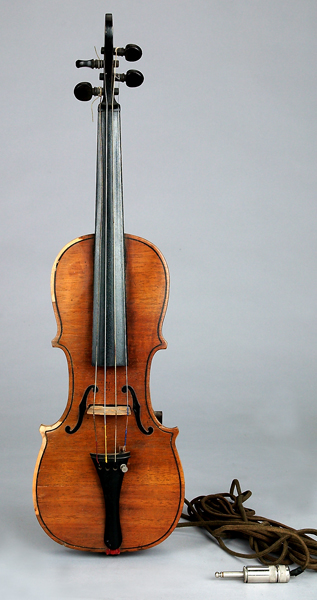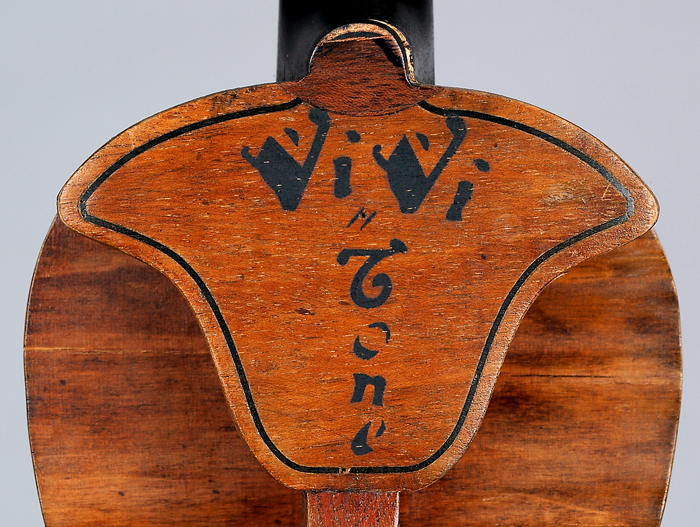Digital Violin
The Violin is Dead

Long Live the Violin
LLOYD LOAR "Vivi-Tone" (1933)
UNITED STATES PATENT OFFICE (2,020,842)
STRINGED MUSICAL INSTRUMENT
Lloyd A. Loar, Kalamazoo, Mich., assignor to Acousti-Lectrjc Company, Kalamazoo, Mich., a corporation of Michigan
Application July 31, 1933, Serial No. 682,976
Patented Nov. 12, 1935
This invention relates to stringed musical instruments, and more particularly concerns instruments of the bowed and plucked string types, such as, but not limited to, those of the viol, mandolin, guitar, and banjo families.
The principal objects of the invention are to provide stringed instruments of special construction, which are played in the same manner as the various instruments of the types and families mentioned, and preferably simulate them more or less in general appearance, but in which the usual hollow instrument bodies are omitted, or are so changed in construction and so employed as to eliminate certain hereinafter described objectionable characteristics which they would otherwise possess as resonant sound-amplifying chambers, and to provide a novel means, highly sensitive to the finer tonal characteristics of the different instruments, through which desired qualities of the tones produced by the string vibrations may be selected, accurately registered and faithfully reproduced, and adjustably and evenly amplified in volume. Further objects and advantages of the invention will appear from the description to follow.
It is well known that stringed musical instruments, which appear to be exactly alike in details of construction, often vary greatly in their tonal qualifications. This is particularly exemplified in instruments of the viol type, wherein, for example, due to its superior quality of tone, one violin may be valued at thousands of dollars, while its apparent replica may lack such qualifications and have comparatively no value.
There has been no way known to definitely determine, in the course of its manufacture, assembly or adjustment, the character or exact timbre of tone an instrument will possess when completed. In the usual and well known forms of stringed instruments already mentioned, the strings are stretched over bridges supported upon the tops or bellies of the respective sound-amplifying chambers forming the bodies of such instruments, and, since these sound-amplifying chambers are of fixed dimensions, they necessarily possess inherent resonant vibratory frequencies, so that they are sympathetically responsive to certain tonal vibrations more than others, and consequently amplify these tones to a greater degree and thereby produce an unevenness in the tonal scales of the respective instruments. In addition to producing unevenness of tonal volume in the scale or range of a single instrument, the employment of an amplifying chamber of fixed dimension also renders it possible to obtain the same character of tone from the different strings, or for the different notes of the scale obtained from any one string of the instrument. Character of tone is produced by the combination of tonal partials, and is a composite of such partials, and an amplifying chamber of fixed dimensions is responsive to certain tonal partials more than others, while some are wholly lost or damped, for the same reasons that it is responsive to certain tonal fundamentals more than others. The recognition of these conditions is evident in the employment of different sizes of instruments of the same family, for example, the violin, viola, violoncello, and bass viol, the tonal ranges of the different instruments requiring sound-amplifying chambers of correspondingly different dimensions. This method .of apportioning divisions of the musical scale to different instruments is carried out in other families of stringed instruments, and smaller divisions might be made by adding more instruments to each family, but this would not remedy the aforesaid undesirable conditions as they exist in each instrument.
My invention does not contemplate changing the number of instruments comprising a family of instruments, nor does it involve changing the musical range or the desirable characteristic tonal qualifications properly belonging to the different instruments, but it does provide improvements in the quality of tone of the instruments, in the direction in which superior instruments are distinguished as such from their fellows, employing means by which a manufacturer may predetermine and fix preferred tonal qualities in such instruments as standards, and may duplicate such tonal qualities and follow such standards in other such instruments. It also provides for the production of even tonal volume and character throughout� the musical scale and tonal range of each instrument, the convenient and exact control of volume amplification, and the production of undistorted tone from an instrument to any intensity desired. I believe I am the first to provide a construction which is designed and serves to correct the undesirable conditions I have mentioned, and/or which possesses the highly desirable features and qualifications indicated.
...
Although the prevailing methods of constructing and supporting the string bridges of instruments of the viol family, together with the design and structure of the bodies of such instruments, render them exceptionally responsive to tonal partials, so that the tones of these instruments are much richer in character than those of other classes and families of stringed musical instruments, there are many of the string tone-partials existent in the respective strlng-bridges which are lost in the flexibility of the bridges and the stiffness of the body-structure of the instruments.
Careful measurements have shown that, when permitted, the string-bridges of instruments of the types here concerned register the various directional vibrations of the strings stretched thereover. These vibrations are undulatory and oscillatory, and extend longitudinally, transversely, and perpendicularly of the strings. Consequently in order to amplify the tones produced by such vibrations of the strings, it is necessary that the bridges be so supported that they may vibrate with and transmit such string movements. By eliminating the usual instrument bodies as sound-amplifying chambers, I avoid their afore said uneven amplification of tonal volume and character, and by supporting the string-bridges in the manner I shall describe, I provide for a more so accurate registration and faithful reproduction of desired qualities of the tones produced by the string vibrations.
...
Instruments embodying my invention have many practicable uses. The electrical output of the magneto-acoustic unit is amply sufficient to operate head-phones, and there is no opportunity for extraneous sounds to be registered, as would be the case if a modulated power circuit were employed. There is no opportunity here for battery, power-circuit, or static electrical disturbances to interfere or distort. The device is extremely sensitive to string-vibrations, but not to extraneous electrical disturbances, and cannot register sound-chamber echoes and distortions of tone, since there is no sound-chamber or sound-board to produce them. Neither is it unduly sensitive to extraneous noises incidental to the playing of the instrument, such as impact of the fingers on the strings and finger-board, brushing of clothes against the body of the instrument, and noise from the vibrator (bow, pick, or fingers) used to vibrate the strings.
The instrument is particularly useful for practice purposes, the audible tones directly produced thereby being weak and undisturbing to others even In the same room. By using the headphones, the player may hear all of the qualities of tone produced by his playing, to the exclusion of other sounds. Consequently, a number of instruments may be simultaneously played in the same room, without any of the players being disturbed by the playing of others. The use of mutes upon the regular instruments, and the use of practice dummies, prevents the player from obtaining the true characteristic tone of the instrument, but the use of the instrument herein described causes no distortion of tone, regardless of volume. By using the amplifier and loud-speaker system, the tones of the individual instrument may be amplified in volume to a degree which the player himself may adjustably determine by means of the adjusting knob or the pedal, limited only by the limitations of the amplifying and loud-speaker unit. In this manner, the player may adjust the volume of tone for salon or concert performances to a nicety, without sacrificing or distorting tonal characteristics.
for more please visit the National Music Museum where this instrument is kept

This work is licensed under a Creative Commons Attribution-NonCommercial-NoDerivs 2.5 License.
up



